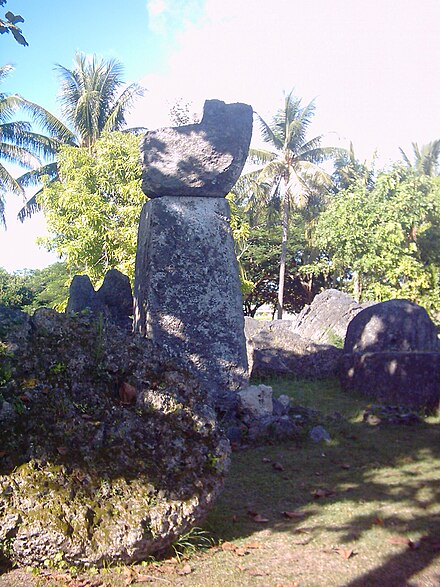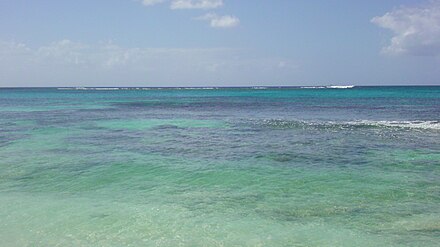Tinian - one of the three principal islands of the Commonwealth of the Northern Mariana Islands
Tinian is one of the Northern Mariana Islands in the Commonwealth of the Northern Mariana Islands, an unincorporated territory of the United States of America. It is just south of Saipan.
Understand
Tinian is a small island 50 miles (80 km) north of Guam and about 5 miles (8 km) southwest of its sister island, Saipan, from which it is separated by the Saipan Channel. The island has a land area of 39 sq mi (101.01 km²).
Tinian is the least populated of the three main Mariana Islands that constitute the Commonwealth of the Northern Marianas Islands.
History
The island has a strong historical legacy remaining from the Pacific war of the 1940s.
Tinian was a Protectorate of Japan following World War I having been both a Spanish and then a German possession prior to coming under Japanese administration in 1914. Tinian was largely a sugar plantation area in the pre Pacific war period. Large-scale military construction began on Tinian in 1939, during the Japanese military buildup in the Pacific,. 1,200 prisoners of war were sent to the island from Japan for the construction of airfields as part of the defense of the Mariana Islands. By 1944, the island had three military airfields with a fourth under construction. What would later become North Field under US control was Ushi Point Airfield, a Japanese fighter airstrip of 4,380 ft (1,335 m) in length.
The island was captured from the Japanese in July 1944 in the Battle of Tinian. Following a 13-day naval bombardment of Tinian leading up to the invasion at Unai Chulu, U.S. forces utilized napalm bombs against the Japanese. It was the first time napalm bombs were used during warfare. The US Marine landing force overcame the numerically superior Japanese force on 1 August 1944 in what is considered to be the best-executed amphibious landing operation of the war. US Marine casualties were 328 dead with 1,571 wounded. The Japanese lost 8,010 dead. Only 313 Japanese were taken prisoner, many Japanese service personnel and civilians were reported to have committed suicide rather than face capture. Several hundred Japanese troops held out in the jungles for months following the capture of the island. Following the conquest of the island Tinian subsequently became an important operational base for the rest of the Pacific war.
The exact figure is unknown however it is understood that approximately 5,000 Korea civilian laborers died in the Marianas during the Pacific war. There is a small cluster of monuments on the island placed there in their memory.

In December 1944, the US Joint Chiefs of Staff made the decision that the newly captured islands in the Marianas in the central Pacific should have airfields built on them to support long range strategic bombing operations against the Japanese. Once under American control, a massive construction project was begun on the island in mid-August 1944. The previous Japanese airfield sited there was repaired and considerably expanded, being named as West Field, or Gurguan Point Airfield due to its geographical location. West Field became operationally ready in the early spring of 1945, and the Twentieth Air Force XXI Bomber Command 58th Bombardment Wing was assigned there and initiated strategic bombardment operations directly against the Japanese Home Islands. After the Japanese surrender, groups of the 58th Bomb Wing dropped food and supplies to Allied prisoners of war in Japan, Korea, and Formosa, and took part in show of force missions. Beginning in September, the vast majority of its fleet of B-29 superfortreses were returned to the United States as part of "Operation Sunset". The 58th Bomb Wing returned to the United States on 15 November 1945, and its subordinate units were either inactivated or reassigned to other bases in Okinawa or returned to the United States.
Rebuilding the captured Japanese air strip at the north end of the island was one of the largest engineering projects of World War II. The massive engineering project created the largest airfield in the world at that time. Four vast 2,600 m runways assisted in the launching of 19,000 combat missions against Japan. With the departure of the USAAF, a part of the former wartime airfield has been used as a commercial airport and for general aviation use. The island is still considered an important strategic asset by the US to ensure the ongoing availability of a potential forward basing location in the Pacific. In 1983, a lease agreement covering these lands was signed and the United States DoD assumed control and possession over the northern two-thirds of Tinian. The lease agreement was for 50 years, with a renewal option for an additional 50 years. The United States Navy continues to utilise the Northwest Field area north of the airport for artillery training, and offers tours of the area when not being used for training.
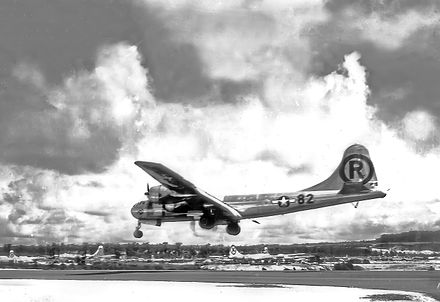
The Enola Gay was one of fifteen Silverplate B-29 strategic bomber aircraft assigned to the 393rd Bombardment Squadron of the 509th Composite Group of the XXI Air Force on Tinian Island during the Pacific War. The aircraft arrived at Tinian on 6 July 1945.<br>The Enola Gay took off from West Field at 2:45AM on 6 August 1945, carrying the first atomic bomb to be used in warfare, and later released it over Hiroshima, Japan. 12 hours and 13 minutes later, the Enola Gay landed at Tinian Island, having completed its mission. Prior to flying the first atomic combat mission, the Enola Gay had flown eight practice missions and two bombing missions over Japan from Tinian. The second bomb, dropped over Nagasaki, was also flown from West Field on Tinian. Tinian was also the last port of call for the U.S.S. Indianapolis. Having carried the two atomic bomb cores to Tinian for assembly into the weapons, she departed for the Philippines but was sunk 4 days later. The ship was considered to be the pride of the US Navy at that time, and great controversy surrounded the sinking.
Over two thirds of the island is still retained by the U.S. military and the island has many historic relics of the Pacific war era.
Culture
Most of the population of Tinian are of indigenous Chamorro descent or are the people of other islands in the Caroline Islands. There are also minorities of East Asians and people of European descent. On Tinian, the Chamorro people speak English and Japanese. Religious beliefs are a mixture of local traditions with Roman Catholic influences. The culture is a mix of original Chamorro culture with influences from 200 years of Spanish colonial rule and Japanese culture. The Spanish influence is seen not only from Catholicism but also from a somewhat modified form of the Cha-Cha-Cha dance. Japanese cultural influence can be still seen on Tinian through the presence of Japanese Shinto shrines.
Talk
Languages spoken in the region are Philippine (Tagalog language), Chinese, Chamorro, English and mixed Pacific island languages.
Tinian Island is home to a Voice of America (VOA) radio relay station. The United States Information Agency, whose headquarters in Washington, D.C., chose Tinian as the site to build a new radio relay station to transmit its VOA broadcasts. The VOA broadcasts more than 900 hours of programming weekly in 47 languages, including English, to an international audience.
Climate
Tropical marine; moderated by northeast trade winds, little seasonal temperature variation. Dry season December to June, rainy season July to October. The typhoon, or hurricane, season lasts several months and starts in late August to early September.
Get in
For information about entry requirements, see the main article on the Northern Mariana Islands.
Tinian is most easily accessed from the neighboring island of Saipan, which has international and regional air connections available.
By plane
- Tinian International airport (IATA: TIQ), 14.999167°, 145.619444°. has a paved runway of 8,600 x 150 ft (2,621 x 46 m) and is a public airport.
Commercial flights are available only from Saipan, the main island, which is a 10-minute flight to Tinian.
- Star Marianas, +1 670 433-9998 (Reservations), +1 670 433-9988 (Tinian terminal), tiqstation@gmail.com. Charter operations between Saipan and Tinian. POA
By air, Tinian is only 35 minutes away from the US territory of Guam.
All departing travellers must pass through US Transportation Security Administration (TSA) checkpoints; if you are continuing on to Guam, you need a US Passport, a valid US visa, or to be a citizen of a Visa Waiver Country (VWP) (dead link: January 2023) as the US government controls Guam immigration.
By boat
The main quay has a usable length of 2200 ft with depths varying between 25 and 29 ft (7.6-8.8 m). There are two piers, pier 1 and pier 2 lying to the southwest of the main quay. Each has a usable length of 500 ft at both sides and a depth of 25 ft (7.6 m). Two shorter quays between the main quay and pier 1 and between piers 1 and 2 have 225 ft of berthage space each and a depth of 25 ft (7.6 m), bringing the total berthing space to 4650 ft. The new part of the main quay is normally occupied by United States Navy ships
- Short quays in a shallow lagoon at the northwest end of the inner harbour are used by local craft.
- The inner harbour has an anchorage area but it is very small with a diameter of only 1000 ft. The bottom of the anchorage basin consists of coral and sand providing reasonable holding. Some protection is provided from winds, especially those between north and southeast. For winds between south and west some protection is provided by a breakwater built on the barrier reef that fronts the town. The northwestern end of the main quay offers the best protection from storms.
The outer anchorage area provides little no shelter especially from westerly winds. There is very little protection provided from easterly winds except close to the shore.
By ferry
- Tinian and Saipan Ferry, +1 670 328-2233. The ferry making four daily roundtrips between Tinian and Saipan $26 round trip
Get around
Car, scooter and MoPed rentals are available. Enquire at one of the outlets across the road from the Dynasty hotel and casino or elsewhere on the island.
See
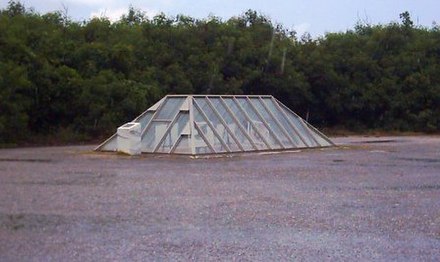

Tinian's main attractions are the airstrips used by the US military during World War II. The airfield was earlier known as West Field, or Gurguan Point Airfield following massive re-building of the original Japanese constructed airfield in 1945. The newly expanded airfield became operationally ready in the early spring of 1945, and the US 20th Air Force XXI Bomber Command 58th Bombardment Wing was based there.
- North Field is where the remains of the US bomber base and Atom Bomb Pits are located. The remains of Japanese fortifications, can also be found there. There is a memorial on the old airfield at the loading pits. These historic Atom Bomb loading pits had been filled in for safety. Both pits were reopened in conjunction with the 60th Anniversary Commemoration of the Battles of Saipan and Tinian (in 2004). The United States Navy leases the Northwest Field area north of the Airport for artillery training, and offers tours of the area when not being used for training
- Enola Gay monument. At the north end of Tinian there is a monument where the B-29 bomber Enola Gay took off carrying the first atomic bomb, later released over Hiroshima, Japan on 6 August 1945.
- Shinto shrine. Tinian is home to the only remaining Shinto shrine in the Mariana Islands, an artifact from the days of Japanese colonisation.
- Chief Taga's House is a traditional Micronesian island chief's house.
- Limestone pillars and capstones Latte Stone structures produced by the island's ancient inhabitants around 1500 BC are still puzzling as to their origins and meaning.
- The Blow Hole, massive columns of water shoot up to 10 m high, a result of waves entering cavities under a limestone ledge and forcing sea water upwards under pressure.
Do
- Explore the island and its Japanese colonial heritage as well as the relics and history or the Pacific war and the islands occupation by US forces.
- Gambling The attractions of the island's casino serve as a significant lure to many visitors as do the popular karaoke bars.
Casino games include slot machines, poker machines, Sega Royal Ascot (bet on which horse will finish 1st or 2nd place), blackjack (also known as 21) and baccarat, roulette, pacific poker (classic 5-card stud poker), craps, Texas hold Em' poker (the best five-card poker hand out of seven cards), Sic Bo (of ancient Chinese origin, also known as big and small or hi-lo and played with three standard dice).
-
Diving and snorkelling
-
The waters around the island have many diving sites including relics of the Pacific war, coral reefs and other attractions.
-
Dump Cove (north and south) - Relic wartime airplanes, tanks, ammunition and vehicles. Good for all skill levels with both shallow and deep areas near its wall. Often has turtles present.
-
Fleming Point – Abundant marine life on coral formations. Drops off to more than 200 feet with good visibility.
-
Tinian Grotto – 3 main entry points into the underwater cavern. Enter from the top to descend into the chamber. Popular site.
-
Turtle Cove – Turtles and Japanese cannon relic inside a cave
-
Two Coral Head – 2 coral formations sitting next to each other. Clear water good for photography.
-
-
Swim
-
Taga Beach, popular with local teenage daredevils for the diving ledge.
-
Tachogna Beach
-
Kammer Beach
-
Chulu Beache
-
-
Fishing
- Bottom fishing and trolling is popular for barracuda, mahi-mahi, marlin, skipjack, red sea bass and tuna.
Eat
- Minako's Cafe, Broadway. Serves a mixture of Japanese, Filipino, Chamorro and American food at reasonable prices
Drink
Sleep
Tinian has few options besides Tinian Dynasty Hotel & Casino, but since the hotel suffers from low occupancy rates, deep discounts may be available.
- Tinian Dynasty Hotel & Casino, 1 Broadway, Taga Beach (5 miles (4.8 km) and 10 minutes away from the airport), +670-328-2233. Check-in: 3PM, check-out: noon. A/C, in-room movies, safety deposit box, mini bar, refrigerator, for wifi (extra charges apply). 412 ocean view rooms, 22 suites and 1 presidential suite. Large communal swimming pool, wide range of restaurants and bars and the islands casino is integrated into the hotel. Complimentary airport transfers are available.
- Meitetsu Fleming Hotel (フレミングホテル), San Jose Village, +1 670 433-3232, TinianMF@pticom.com. 13 50-m² rooms (9 twin rooms, 4 triple rooms), free airport and boat quay transfers, Japanese language hotel, special deals for divers, fee for late check out-5PM. US$60-80+tax
Cope
The currency used is the US dollar (US$).
Power supply voltage on the island is 115 V, at 60 Hz with electrical outlets normally either Type A, or Type B. If coming from Europe, Australasia, or most of Asia (excluding Taiwan & Japan) where 220-240 V at 50 Hz is used then suitable electrical outlet adaptors and transformers will be required to use your electronic equipment.
Stay safe
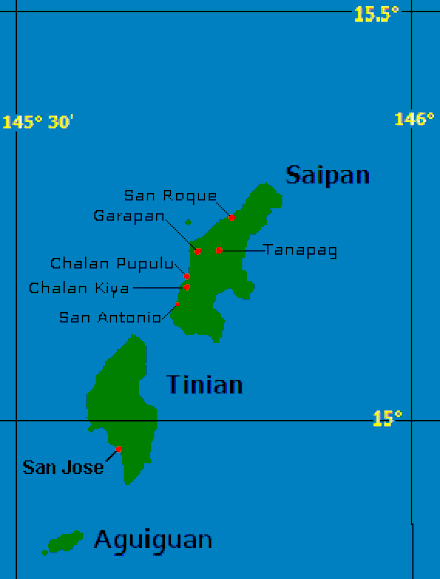
Connect
Standard time zone: UTC/GMT +10 hours (same as Guam).
There is an internet cafe on the first floor of the Tinian Dynasty.
The international dialling prefix for the Northern Marianas Islands 1-670 (Saipan, Rota, & Tinian).
Mail is handled by the US Postal Service.
Go next
The island is in the middle of a large expanse of the Pacific Ocean; however, there are destinations across the water.
Tinian
Primary administrative division

